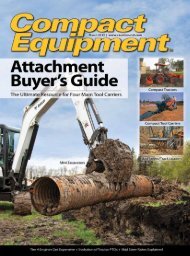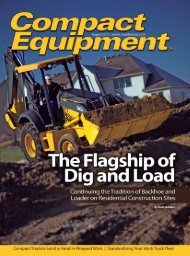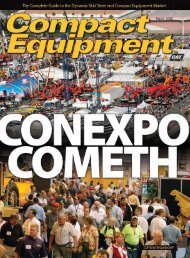CE EQUIPMENT CONNECTION - Compact Equipment
CE EQUIPMENT CONNECTION - Compact Equipment
CE EQUIPMENT CONNECTION - Compact Equipment
Create successful ePaper yourself
Turn your PDF publications into a flip-book with our unique Google optimized e-Paper software.
One way to determine if a compressor is right is by looking<br />
at its “design margin.” Design margin is the ideal operating<br />
level of a machine — the level at which a machine can<br />
produce without working too hard.<br />
One of the most important components of any portable<br />
compressor is the engine. Most portable air compressors<br />
are rated as either continuous or intermittent duty. For<br />
compressors that run all the time, engine horsepower<br />
“margin” (ideal operating level) is typically 85 percent of its<br />
maximum rated horsepower. Compressors that are stopped<br />
and started repeatedly have a horsepower margin of 93<br />
percent of their maximum output.<br />
The engine is the item on the compressor that experiences<br />
the highest amount of wear, according to Flatt. “The actual<br />
compressor doesn’t wear or cause problems. As long as the<br />
manufacturer’s recommended maintenance schedule is<br />
regularly followed and care is taken with the engine, the<br />
compressor will have a long working life.”<br />
Contractors should also be confi dent that the engine is<br />
going to last. Flatt suggests investing in an engine that has<br />
a warranty to back it up and is convenient to have serviced.<br />
“The perfect situation for any purchaser is to buy a piece of<br />
equipment, put it to work in the fi eld and never hear about<br />
it again,” says Flatt.<br />
Options to Consider<br />
Compressors come standard with tail lights and clearance<br />
lights to adhere to government safety regulations, but other<br />
features such as composite end panels, which are more<br />
corrosion resistant and better withstand jobsite conditions,<br />
will help distinguish competitive models.<br />
“A-frame towbars provide greater stability to the unit<br />
during towing because of its wider base design,” says<br />
Flatt, “and lockable latches that protect the unit against<br />
vandalism, are both options that don’t always come<br />
standard but should be considered when purchasing a<br />
compressor.”<br />
Other options to keep in mind when choosing your<br />
compressor are: diagnostic display lights, a generator, a<br />
central drain line and independent torsional suspension,<br />
as well as additional choices, including hoses and fi ttings,<br />
a hose reel, a larger battery, an adjustable hitch, a spare tire<br />
and electric and hydraulic brakes.<br />
An Important Factor<br />
According to Flatt, the most important intangible factor to<br />
consider when making a purchase is the sales support that<br />
comes with the compressor — parts, service, warranties and<br />
the relationship with the dealer.<br />
The dealer should serve as a consultant when selecting the<br />
best compressor. Once the application for the compressor<br />
is determined, the dealer should be able to help match<br />
the intended use to a specifi c compressor size. The dealer<br />
should also be able to provide a guarantee of support after<br />
the sale.<br />
“The reputation of the compressor manufacturer and the<br />
brand name on the product drive customers in this market<br />
to buy,” says Flatt. “If a dealer or a manufacturer’s support<br />
network doesn’t satisfy contractor needs, purchase from one<br />
that does. In the end, sales support is the most valuable part<br />
of the purchase.”<br />
Amber Reed is a technical writer with Performance Marketing in<br />
West Des Moines, Iowa.<br />
A good guide to follow when selecting a compressor is to size the compressor for the maximum tool-to-cfm ratio of the tools<br />
expected to be used. For instance, the largest paving breaker might be approximately 85 cfm; therefore, to operate<br />
one breaker a 90-cfm compressor is needed and for two breakers a 185-cfm sized compressor is needed.<br />
34 <strong>Compact</strong> <strong>Equipment</strong> January 2008 compactequip.com








